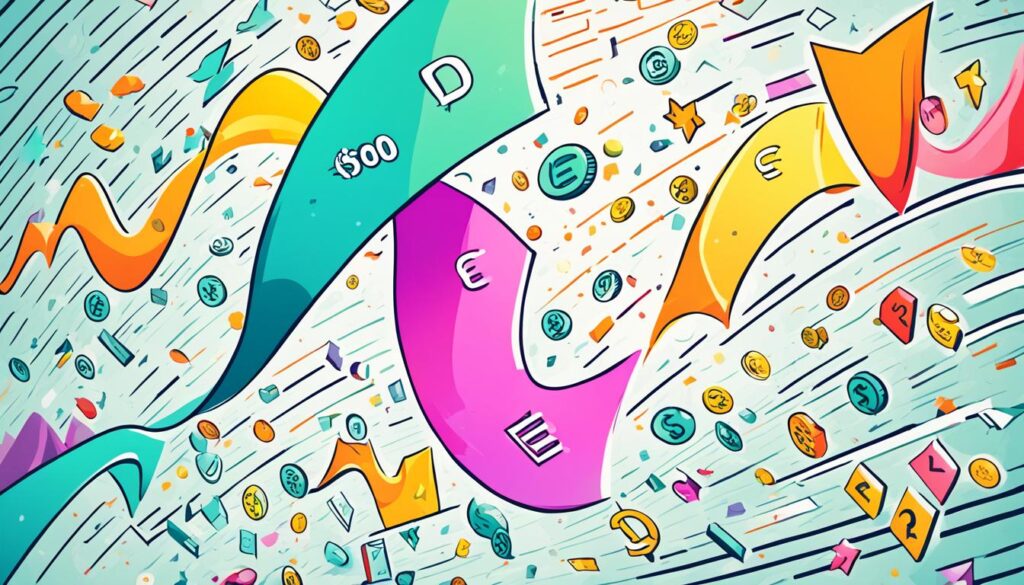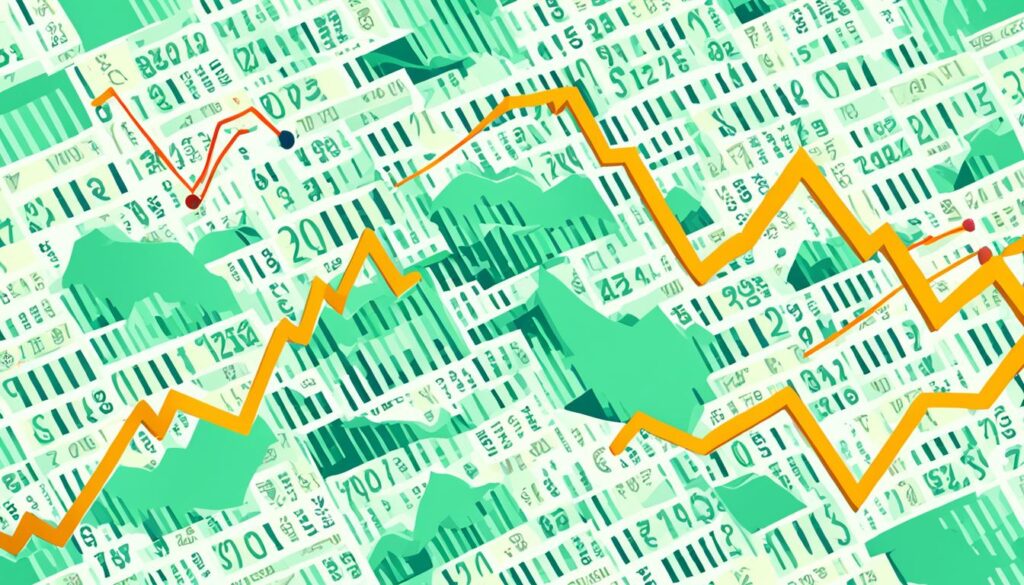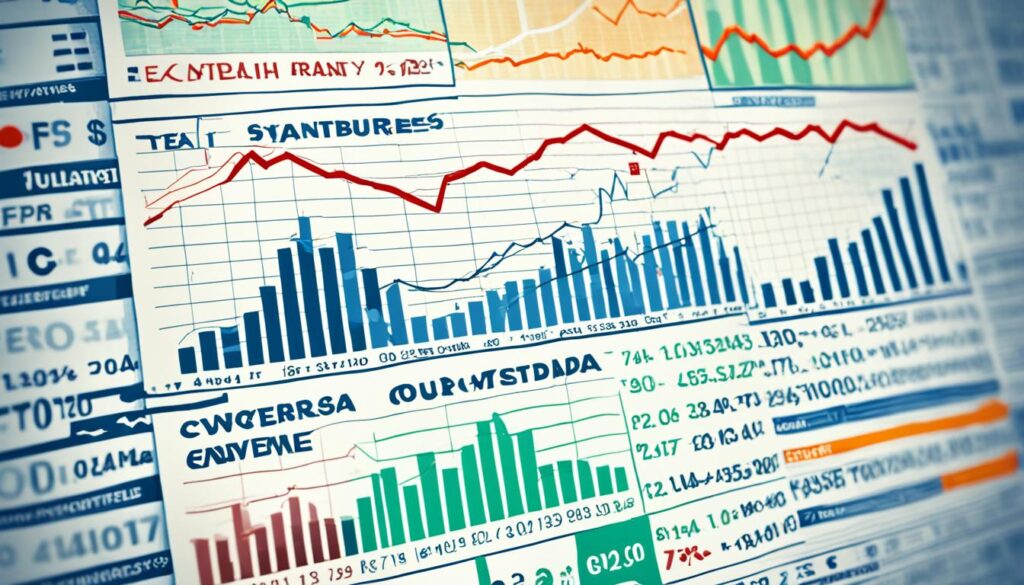Understanding Forex Trading for Beginners: A Guide
The Forex market sees over $6.6 trillion every day. This huge number shows how big and important this market is for the world. Starting out might seem hard, but with the right help, it’s a great way to make money.
It’s important to learn Forex trading if you’re new. This guide is here to teach you all about it. It covers everything from the basic facts to how to keep your money safe.
Forex trading lets you buy and sell currencies from all over. It’s important for businesses, people who invest, and governments. If you’re just starting or trying to get better, learning the basics is the first step. Platforms like TPT Forex and TPT CopyTrading help beginners a lot.
Key Takeaways
- The Forex market has a daily trading volume exceeding $6.6 trillion, highlighting its global significance.
- Understanding Forex trading for beginners involves learning the basics of currency trading and market entry.
- Platforms like TPT Forex and TPT CopyTrading offer valuable tools and resources for new traders.
- Grasping the fundamentals helps mitigate risks and increases the potential for successful trades.
- Forex trading is essential for international trade, investments, and economic activities worldwide.
Introduction to Forex Trading
Starting your journey in the Forex market requires basic knowledge. You should know how the market operates and understand the currency exchange process. This currency trading introduction gives you the essential background to get started.
What is Forex Trading?
Forex trading means buying and selling currencies on a global scale. It differs from stock markets because it’s open 24/5, including cities like London, New York, Tokyo, and Sydney. The Forex market is a vast network connecting banks, businesses, and traders worldwide.
Knowing how Forex trading works is key. It involves trading currency pairs, like buying the Euro and selling the US dollar. Traders make profits off these rate changes, which are influenced by various factors like economic news or politics.
Thanks to platforms like TPT Forex, trading is now open to more people. Tools such as TPT CopyTrading have made it easier for beginners to enter the market.
History of Forex Market
The forex market history starts with the 1944 Bretton Woods Agreement. This agreement set up fixed rates based on the US dollar. However, in 1971, these fixed rates were dropped, leading to the system we have today.
Forex has become a huge market, trading over $6 trillion every day. Innovations like electronic trading have made it easier for anyone to join in, not just big financial institutions.
| Era | Key Event | Impact |
|---|---|---|
| 1944 | Bretton Woods Agreement | Established fixed exchange rates; pegged currencies to USD |
| 1971 | End of Bretton Woods | Initiated floating exchange rates |
| 1980s-1990s | Technological Advancements | Transition to electronic trading platforms |
| 2000s-Present | Rise of Online Trading | Increased accessibility for individual traders |
This currency trading introduction and a look at forex market history is just the beginning. The Forex market presents many opportunities for those wanting to trade.
Forex Market Basics
When you start in the forex market, know there are many currency pairs to trade. Learn about these pairs to make your trading journey smoother and more profitable.
Currency Pairs Explained
Trading in currency pairs means you watch how two national currencies change against each other. The first currency is the base currency, and the second is the quote currency. For instance, in EUR/USD, the Euro is first and the USD is quoted.
The base currency shows how much of the quote currency you need.
When trading, the bid and ask prices define a currency pair’s value. The bid price is the selling price, and the ask price is the buying price. The difference between the two is the spread.

Major vs. Minor vs. Exotic Pairs
Understanding major, minor, and exotic pairs is key for traders. Major pairs are the most traded, which makes them more liquid and have lower spreads. Common majors are:
- EUR/USD – Euro/US Dollar
- USD/JPY – US Dollar/Japanese Yen
- GBP/USD – British Pound/US Dollar
Minor pairs don’t involve the US Dollar. Because they’re less traded, they’re more volatile. Examples include:
- EUR/GBP – Euro/British Pound
- AUD/JPY – Australian Dollar/Japanese Yen
- NZD/CAD – New Zealand Dollar/Canadian Dollar
Exotic pairs join a major currency with one from a smaller economy. These are the least liquid and most volatile. Exotic pair examples are:
- USD/TRY – US Dollar/Turkish Lira
- EUR/SEK – Euro/Swedish Krona
- GBP/ZAR – British Pound/South African Rand
Knowing these pairs helps you trade smarter. Your decisions in selecting currency pairs are vital to your forex strategy.
| Currency Pair Type | Description |
|---|---|
| Major Pairs | Includes the most traded currencies, highly liquid, low spreads. |
| Minor Pairs | Cross-currencies without the US Dollar, moderate liquidity, more volatile. |
| Exotic Pairs | Comprised of one major and one minor currency, less liquid, high volatility. |
Getting Started with Forex Trading Platforms
Choosing the right Forex trading platform is key for success. We’ll look at some popular ones. And we’ll talk about the features of different account types.
Popular Forex Trading Platforms
Many well-known Forex trading platforms exist. TPT Forex is a favorite for its easy-to-use interface and powerful tools.
- TPT Forex: It offers a wide range of features, including real-time market data and various analytic tools. This helps traders make smart decisions.
- MetaTrader 4 (MT4): MT4 is famous for its detailed charts, auto trading, and technical indicators.
- cTrader: It’s known for being easy to use, quick trade execution, and strong risk management tools.
Account Types and Their Features
It’s important to pick the right account type. This depends on your goals and how much risk you want to take.
| Account Type | Features |
|---|---|
| Demo Trading Accounts | Demo accounts let you practice without real money. They’re great for learning the platform. |
| Standard Accounts | Standard accounts are for when you’re ready to trade with real money. They vary in fees and spreads. |
| Premium Accounts | Premium accounts have special benefits like lower spreads and extra tools. TPT Forex offers TPT CopyTrading for following successful traders. |
Understanding Forex Trading for Beginners
Starting in forex trading means knowing more than just the basics. Knowing the forex trading essentials is crucial. It helps you handle the ups and downs of currency markets. This knowledge is key to creating smart currency market strategies and improving your trading skills.
Success in forex trading needs strong trading psychology. Being mentally tough lets you handle stressful trading times well. Staying disciplined, patient, and consistent can be the key to doing well in forex.
Forex experts offer some tips to avoid common mental traps:
- Patience: Waiting for the right setup before trading can prevent bad choices.
- Discipline: It’s vital to stick to your plan, even when the market seems tempting.
- Consistency: Regularly update your strategies to keep doing well.

Having the right mindset in forex is important. But using strong currency market strategies like TPT Forex or TPT CopyTrading can make a big difference. These methods help you deal with different market situations better.
Remember, learning about forex trading essentials takes time. Take things one step at a time, keep learning, and use what you learn to succeed in the forex world.
Choosing the Right Forex Broker
Finding a good forex broker is key to doing well in trading. You need to look at things like their rules, tools they give you, and more.
Regulated vs. Unregulated Brokers
Deciding between a regulated or unregulated broker affects your safety and success in trading. Regulated ones follow strict rules to keep your money safe. Organizations like the CFTC and NFA watch over them.
- Regulated Brokers: Provide more security and clear rules.
- Unregulated Brokers: Can mean more risk, fraud, and less reliable help.
Tools and Resources Provided by Brokers
A broker’s trading tools and resources can make a big difference. The best brokers have many tools to help you do smart trades.
- Market Analysis: They have detailed tools to understand the market better, like charts and trend signals.
- Educational Materials: Online classes and webinars are offered to learn about the forex world.
- Trading Signals: They give you real-time hints on what you should trade.
| Broker | Regulation | Key Tools and Resources |
|---|---|---|
| TPT Forex | Regulated | Advanced market analysis, TPT CopyTrading feature, educational webinars |
| Unregulated Broker | Not Regulated | Basic charts, limited educational content |
Leverage and Risk Management
Understanding leverage in Forex trading is key to success in the market. With leverage, traders can make their trades bigger. But, this also brings a higher risk of losing more money. It’s important to use strong risk management techniques to stay safe. We’ll look at how to use leverage and ways to avoid losing money.

What is Leverage in Forex?
Leverage in Forex lets you control a large trade with a small amount of your own money. It’s like getting a loan from your broker to trade more. For instance, with a 100:1 leverage, you can trade $100,000 by putting down just $1,000. This setup allows for both big wins and big losses if caution isn’t taken.
Risk Management Strategies
Stopping trading losses is essential. Here are some important strategies to help:
- Setting Stop-Loss Orders: These orders close your trade if it starts losing too much. This helps limit how much you can lose.
- Position Sizing: This means making your trades fit the size of your account. It helps avoid putting too much money at risk.
- Diversification: Investing in different things spreads out the risk. This way, you’re not risking everything on one trade.
Using these strategies keeps your trading under control and cuts down on possible losses. Companies like TPT Forex and TPT CopyTrading offer tools and help to use these strategies well.
Technical Analysis for Forex
Forex traders use technical analysis to guess where prices might go next. They look at past data, such as chart patterns and indicators. This helps them decide what to do next in trading.
Chart Patterns
Chart patterns give traders a hint of where the market might head. By spotting these patterns, one can get clues like the possible upcoming direction.
- Head and Shoulders: Shows a possible trend reversal, switching from up to down.
- Double Top and Double Bottom: Hints at a potential change in trend, with the top signaling a bearish shift and the bottom suggesting a bullish turn.
- Triangles: These patterns often show periods of price calm before a big move either up or down.
Indicators and Signals
Forex indicators are key for analyzing trading scenarios. They offer insights on trends and momentum in the market. Here’s a look at some important ones:
- Moving Averages: They smooth out price data to reveal trend direction.
- Relative Strength Index (RSI): It indicates if prices are too high or too low, helping to spot potential reversals.
- Moving Average Convergence Divergence (MACD): It checks on trend power and direction.
By using both chart patterns and indicators, your forex analysis gets stronger. This foundation helps in making better trading choices. To learn more, check out TPT Forex and TPT CopyTrading.
Fundamental Analysis in Forex
Getting fundamental analysis in forex trading right is key to understanding market moves. It looks at economic and political issues that change currency prices. By knowing these, you can choose better.

Economic Indicators
fundamental analysis in forex relies on economic indicators to see how a country is doing economically. Key indicators like GDP, inflation, and jobs can give you big clues about a currency’s strength.
- Gross Domestic Product (GDP)
- Inflation Rates
- Employment Figures
- Retail Sales
- Trade Balance
They let you guess currency power and market directions. For example, a country with high GDP or more jobs might have a powerful currency.
Political Factors
Stable politics and big events are crucial in fundamental analysis in forex. Events like policy changes, big decisions by central banks, or trade deals matter a lot. They can quickly switch a currency’s value.
- Government Stability
- Central Bank Decisions
- Geopolitical Events
- Policy Changes
- Trade Agreements
When a government is shaky, it can mean a weaker currency. This happens because investors lose faith in that country.
| Economic Indicator | Impact on Currency |
|---|---|
| GDP Growth | Stronger |
| High Inflation | Weaker |
| Increased Employment | Stronger |
| Political Instability | Weaker |
| Central Bank Rate Hikes | Stronger |
So really, economic indicators and political factors impacting forex are both big parts of fundamental analysis in forex. Using these ideas can guide you through the forex market smartly.
Developing Forex Trading Strategies
A top Forex trader uses both technical and fundamental analysis. This helps them create a strong strategy. It’s key for dealing with the market’s complexities successfully.
To make a solid trading plan, start with clear goals. Then, use adaptive trading systems. These systems help you adjust to the market’s twists and turns. Testing your strategy against past data is also vital. It proves your approach works before you invest real money.
- Technical Analysis: This involves studying price movements and market signals for smart trades.
- Fundamental Analysis: Here, you look at economic and political news to understand currency changes.
- Backtesting: It means checking how your strategies would have done in the past, to plan ahead.
- Adaptability: Changing your approach to fit different market scenarios is crucial.
Learning from the pros can level up your strategy. For example, John Bollinger of Bollinger Bands fame suggests staying flexible. It’s about following market trends, not just one fixed path.
| Successful Trader | Strategy Highlight | Importance |
|---|---|---|
| John Bollinger | Adaptive Trading Systems | Staying flexible is key for long-term strategy success. |
| George Soros | Macro-Economic Analysis | Seeing the big picture guides wise long-term choices. |
| Paul Tudor Jones | Risk Management Techniques | Effective risk management protects your investment. |
Useful support comes from places like TPT Forex and TPT CopyTrading. They offer tools for making detailed, effective trading plans. This includes using both past and current data for better decisions.
Conclusion
Starting forex trading means diving into a world that’s both thrilling and challenging. You need to be eager to learn and grow constantly. This guide has given you the basics, from understanding how currency pairs work to the types of trading platforms available. Knowing these fundamentals is key to a strong start in forex trading.
Forex trading isn’t a quick way to make a lot of money. It’s about learning and gaining experience over time. Choosing a reliable broker, learning how to manage risks, and making detailed trading plans are all very important. Services like TPT CopyTrading by TPT Forex can make your trading experience smoother.
It’s important to tread carefully through the complex world of finance, always ready to learn more and adapt to change. Keeping up with new market trends, economic news, and political events that impact the forex market is essential. Keep educating yourself and trying new strategies to improve your trading skills. This way, you’ll not just be part of the market, but you’ll have a better chance to succeed.
